|
|
|
Sort Order |
|
|
|
Items / Page
|
|
|
|
|
|
|
| Srl | Item |
| 1 |
ID:
140346
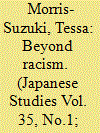

|
|
|
|
|
| Summary/Abstract |
The special issue ‘Rethinking Race and Racism from Japanese Experiences’ explores how racism operates in modern Japan. This article contributes to that exploration by examining how racism is situated within a nexus of interrelated forms of discrimination and marginalization. In the article I propose the notion of ‘semi-citizenship’ as one framework which can help us to go beyond unfruitful zero-sum-game visions of marginalization put forward by racist groups such as the Zaitokukai in Japan. Rather than envisioning a dichotomous contrast between ‘citizen’ and ‘non-citizen’, the idea of semi-citizenship allows us to think of a range of different sets of social positions stretching towards the idealized vision of the ‘full citizen’. We can then start to consider how such social positions are distributed within modern societies, how they are influenced by factors such as ethnicity, gender and physical and mental attributes, and how the distribution changes over time. This approach offers a common ground on which various kinds of marginalization may be related and understood together, potentially providing a basis for collaborative work to create a more equitable Japanese society.
|
|
|
|
|
|
|
|
|
|
|
|
|
|
|
|
| 2 |
ID:
171303
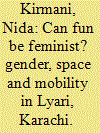

|
|
|
|
|
| Summary/Abstract |
The densely populated, multi-ethnic area of Lyari in Karachi is one of the city’s original settlements. The area has become infamous as the site of an ongoing conflict between criminal gangs, political parties and law enforcement agencies for over a decade, and, for this reason, Lyari has been labelled as one of several ‘no-go areas’ in the city. However, for the residents of Lyari, the ways in which they understand their part of the city far exceed these facile labels. While at times their neighbourhoods do become fearful spaces, they are also places of comfort, familiarity and fun. This article explores the multiple ways in which women and girls experience and understand this area. In particular, it documents the various ways in which they express and experience enjoyment in their everyday lives and during exceptional moments. Based on extensive interviews and participant observation in several neighbourhoods, the research shifts attention away from solely using violence as a lens to understand urban space and away from seeing women mainly as victims of violence. Focusing on the pursuit of fun and enjoyment as an area of academic inquiry can be an important way to show how women push against and challenge patriarchal boundaries. By highlighting women’s and girls’ own creative navigations and engagements with their locality and the city, this paper brings new insights into discussions of gender and urban marginalisation more generally.
|
|
|
|
|
|
|
|
|
|
|
|
|
|
|
|
| 3 |
ID:
129539
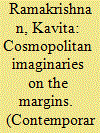

|
|
|
|
|
| Publication |
2014.
|
| Summary/Abstract |
In this article, I examine how social boundaries are drawn and contested by residents in a Delhi resettlement colony, established in 2004 and expanded during the wider slum clearance drive, prior to the 2010 Commonwealth Games. Drawing from life narratives, I explore how residents navigate new social terrains and decide in which situations difference becomes a salient issue. Building on literature that engages with subaltern forms of cosmopolitanism, I argue that openness and conviviality are seen as predominantly urban behaviors, external to that of the colony located on the margins of the city. Residents instead express ambivalent and sometimes contradictory subjectivities in quotidian encounters, and often see social distancing as a necessary tactic. I suggest the narratives offer a nuanced understanding of the multiple constructions of home, community, and belonging amongst the marginalized in and 'beyond' the city.
|
|
|
|
|
|
|
|
|
|
|
|
|
|
|
|
| 4 |
ID:
183920
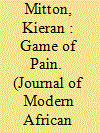

|
|
|
|
|
| Summary/Abstract |
Within two decades, Sierra Leone's ‘cliques’ have transformed from peripheral social clubs to warring Crips, Bloods, and Black street gangs at the heart of criminal and political violence. Nevertheless, they remain severely under-studied, with scholarship on Sierra Leonean youth marginality heavily focused on ex-combatants. Drawing on extended fieldwork with Freetown's cliques as they played the ‘game’ – the daily hustle to survive and resist the ‘system’ – this article offers two main contributions. First, it addresses the knowledge gap by charting the origins, evolution and contemporary organisation of these new urban players. Second, it argues that although this history reveals continuity in perennial forms of youth marginalisation, it also shows that the game itself has changed. Cycles of escalating violence and growth are hardwired into this new game. Exacerbated by a political system that sustains and exploits them, cliques present a far greater challenge to everyday peace than has hitherto been recognised.
|
|
|
|
|
|
|
|
|
|
|
|
|
|
|
|
| 5 |
ID:
151207
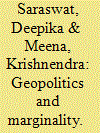

|
|
|
|
|
| Summary/Abstract |
Theorisation in modern geopolitics is replete with instances where certain regions have been accorded a marginal status in various schemes of global political–geographical configurations. Geopolitical ideas propounded by Halford J. Mackinder, Nicholas Spykman and Saul B. Cohen are all evidence of geopolitical visualisation and ordering which advantage certain parts of the world by geo-graphing them as strategically important. This ordering disadvantages certain other areas as less important and, therefore, marginal in the context of international politics. The study here attempts to locate the ascription of marginality in modern geopolitics.
|
|
|
|
|
|
|
|
|
|
|
|
|
|
|
|
| 6 |
ID:
080622
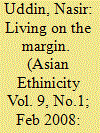

|
|
|
|
|
| Publication |
2008.
|
| Summary/Abstract |
The Chittagong Hill Tracts (CHT) of Bangladesh has long been represented as a region of multi-ethnic setting, ethnic conflict and ethnic movement in South Asia. However, inter-ethnic relationship through the practice of unequal power and positions among the 'Pahari' (hill-people), the inhabitants of the CHT, has largely been ignored in the deeper understanding of the CHT. In addition, available CHT literature talks mostly about numerically dominant ethnic groups, whereas less attention is paid to the marginalized 'Pahari' ethnic groups. This paper examines the positioning of the 'Khumi', one of marginalized Pahari ethnic groups, within the larger canvas of CHT vs state across times and regimes. In an attempt to identify the position of the Khumi within the sociopolitical and ethnic history of the CHT, it seeks answers to three central questions: (a) How did the Khumi appear in the demographic configuration of the CHT? (b) How had they, along with the CHT and its other inhabitants, been dealt with during the colonial and postcolonial regimes? (c) How do they position themselves in the recurrent sociopolitical dynamics of CHT vs state relationship? The paper is based on critical consideration of secondary sources on the region in collaboration with relevant comprehensive data collected through ethnographic fieldwork undertaken from November 2005 to April 2007 in the CHT of Bangladesh
|
|
|
|
|
|
|
|
|
|
|
|
|
|
|
|
| 7 |
ID:
169996
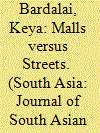

|
|
|
|
|
| Summary/Abstract |
This paper explores the experiences of migrant women from Northeast India who work in retail stores in malls in Delhi and Gurgaon, and the conflicting discourses of modernity and marginality which they negotiate at work and outside work. Managers of high-end retail stores in malls view these women as ‘modern’, ‘global’ and reflective of the aesthetic sensibilities of the brands they are hired to sell. For this reason, north-eastern women’s bodies and identities are ‘valued’ and ‘sought after’ by retailers and recruiters. Yet, outside, especially on the streets of Delhi, the same women whose aesthetic and modern attributes are valued at the workplace are subject to racial and sexualised stereotyping that labels them as ‘promiscuous’, ‘provocatively dressed’ and lacking in sexual respectability. This paper describes the spatial practices of north-eastern migrant women as inscribed by the shifting landscapes of modernity and marginality that they must negotiate as they reconcile their different public identities in the city.
|
|
|
|
|
|
|
|
|
|
|
|
|
|
|
|
| 8 |
ID:
103170
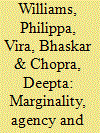

|
|
|
|
|
| Publication |
2011.
|
| Summary/Abstract |
The idea of the state has shown remarkable resilience over the last couple of decades, despite assaults on it from neoliberal doctrines and the forces of globalization. During this period, the abiding presence and role of the state has been particularly evident in the contemporary political life of the Asia Pacific region. This article pays special attention to the contemporary Indian state in the context of development. It reflects upon the ways in which the state is experienced, by focusing on questions of marginality, agency and power as they intersect the politics of development. By reading the empirical insights documented within this special issue against a rich trajectory of scholarship on the Indian state, the article argues that there has been a recent qualitative change in the way in which the contemporary Congress-led UPA government has presented itself to the common person. The implementation of pro-poor and more inclusive policies has altered the discursive landscape within which state-society interactions have taken place over the last five years. Importantly, these policies have functioned to reconfigure not only the material interactions between the state and India's marginalized, but also the imagined spaces within which marginal groups renegotiate their relationships with the state.
|
|
|
|
|
|
|
|
|
|
|
|
|
|
|
|
| 9 |
ID:
167384
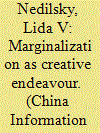

|
|
|
|
|
| Summary/Abstract |
Creative work is best understood as a process of getting lost. Scholarly work is a creative endeavour. And an endeavour requires total attention. On a superficial level, total attention is a demonstration of scholarly seriousness and discipline. On a deeper level, total attention is a necessary effort for successful scholarship. Yet, do we as scholars see getting lost as a necessary precondition for total attention? The authors whose works are showcased in this special issue of China Information add to our appreciation of marginalization as creative endeavour. They do so by means of scholarship highlighting the creation of marginal existence through the application of labels and locators that stick and shift. They do so, moreover, because of their willingness to share their particular experience of getting lost. That experience includes challenges to professional and personal identity when their own status – whether religious, racial, ethnic, or sexual – is called into question.
|
|
|
|
|
|
|
|
|
|
|
|
|
|
|
|
| 10 |
ID:
133591
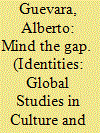

|
|
|
|
|
| Publication |
2014.
|
| Summary/Abstract |
A group of elderly women set up prayer camps in public roundabouts throughout Nicaragua's capital, Managua, to pray for 'peace and reconciliation.' A few miles away, in a humble barrio, escaping sexual discrimination and violence, a 24-year-old transvestite performs a sexually charged act in a circus. Meanwhile, across from the national parliament, hundreds of ex-agricultural workers exposed to the pesticide nemagon exhibit their dying flesh to the nation and the world in order to expose corporate greed and government inaction. These cases, happening under the new Sandinista regime, reflect a plurality of social spaces where theatricality, as the rhetorical manipulation of spaces and bodies aiming to affect publics, has become a mechanism for revealing the interstices of power relations in present day Nicaragua. This work explores various instances of linked and entwined government-sponsored and -sanctioned social performances of power and visibility, as well as other social performances that draw attention to the gap between the rhetoric of the government and social reality.
|
|
|
|
|
|
|
|
|
|
|
|
|
|
|
|
| 11 |
ID:
124974
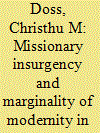

|
|
|
|
|
| Publication |
2013.
|
| Summary/Abstract |
This article argues that despite some efforts by early missionaries, Christians in India have continued to practise various forms of caste prejudice. The multi-dimensional understanding of caste made this issue heavily contested, dividing the Christian communities into two major components of marginal Christians, later known as Dalit Christians, and elite Christians constituting largely Nadars and Vellalas in South India. Despite considerable missionary misgivings about caste identities and resultant discriminations, traditional differentiation carried on and took new forms. This article traces these debates and shows the challenges of opposing caste-based discriminations that continue today.
|
|
|
|
|
|
|
|
|
|
|
|
|
|
|
|
| 12 |
ID:
107218
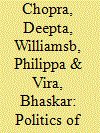

|
|
|
|
|
| Publication |
2011.
|
| Summary/Abstract |
This introduction discusses the articles in this Special Issue, which are all focused on exploring the everyday interactions between marginalised individuals and groups and the state in contemporary India. In particular the articles highlight the experiences of a diverse set of marginalised groups - Muslim artisans and weavers, Dalits, Tibetan exiles and post-conflict victims in Gujarat - in order to work towards an understanding of the politics of citizenship from the margins. Across these articles two interlocking themes emerge. Firstly, how different marginalised groups have experienced, critiqued and engaged with different aspects of the `welfare state'. Secondly, the way in which agencies were articulated from the margins through these processes of engagement, shaping and recasting interactions between the state and society in India. We argue that the deployment of different strategies of engagement with the state by India's marginalised can be viewed as a politics of citizenship, through which marginalised people (re)make themselves as citizens. This essay is thus a call for future research on citizenship as a lived experience which is operationalised in local practices and quotidian interactions between the state and society.
|
|
|
|
|
|
|
|
|
|
|
|
|
|
|
|
| 13 |
ID:
113791
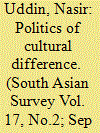

|
|
|
|
|
| Publication |
2010.
|
| Summary/Abstract |
This article analyses the formation of an ethnic category and its relations with the marginalisation of ethnic minorities in the context of upland-lowland relations in Bangladesh. Three central concerns are highlighted. First, it examines the political and historical trajectories of the South Asian subcontinent which has laid down various identities for groups of people such as the Pahari living in the Chittagong Hill Tracts (CHT) of Bangladesh. Second, it critically discusses how colonial policy has continued in the postcolonial era, particularly in dealing with people of different cultures living in the same state's territory. Finally, the article argues that identity formation is closely linked with the politics of marginality, with particular reference to the Pahari people of the CHT. The article is based on comprehensive data collected through ethnographic fieldwork undertaken at different times from 1997 onwards.
|
|
|
|
|
|
|
|
|
|
|
|
|
|
|
|
| 14 |
ID:
162408
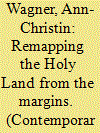

|
|
|
|
|
| Summary/Abstract |
Mafraq, a Jordanian border town, has been profoundly reshaped by the influx of Syrian refugees since 2011. As aid agencies were initially absent from the humanitarian response, the gap was filled by faith-based organisations. In an academic and policy environment narrowly focused on security issues, Islamic charities have received considerable attention. However, little is known about the activities of Evangelical groups, let alone Arab Evangelicals, and how giving aid becomes embedded in wider religiopolitical projects. This article explores how the Mafraq Unity Church, an indigenous Evangelical congregation, balances its religious identity with an increasingly professionalised NGO ‘business’. Drawing on fourteen months of ethnographic fieldwork in 2016/17, I argue that through tapping into resources from secular and non-secular transnational networks, the church appeals to two ‘international communities’: the aid industry and Evangelical communities worldwide. The church's rootedness in northern Jordan speaks to the humanitarian sector's recent ‘localization of aid’ agenda, while its benevolent activities are also framed as part of worldwide Evangelism. This allows Jordanian church officials to rhetorically shift Evangelism's centre of gravity to the Global South and move Mafraq closer to the demographic and historical centre of Christianity.
|
|
|
|
|
|
|
|
|
|
|
|
|
|
|
|
| 15 |
ID:
079930
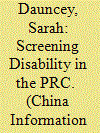

|
|
|
|
|
| Publication |
2007.
|
| Summary/Abstract |
This article outlines the political, social, economic, and cultural factors affecting disability representation in Chinese cinema from the founding of the PRC onwards, particularly after 1976. With reference to a wide variety of films that include main characters with visual, hearing, speech, physical, and learning impairments, it demonstrates how socialist realism, the equation of a "healthy" body with a healthy nation, and the great economic endeavor of the Mao era all contributed to the limitation of disabled people on the big screen, whilst the opening-up reforms, spiritual civilization campaigns, and commercial and critical demands of the post-Mao era effectively promoted their inclusion. At different times, the marginality of disabled people has resulted in them being overlooked as irrelevant, rejected as impaired, employed as a political tool, or identified as a marketable commodity. The representation or nonrepresentation of disability in Chinese film is closely linked to the politics of looking good
|
|
|
|
|
|
|
|
|
|
|
|
|
|
|
|
| 16 |
ID:
054386
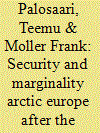

|
|
|
| 17 |
ID:
191063
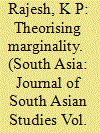

|
|
|
|
|
| Summary/Abstract |
Despite the accepted usage of ‘marginality’ as a subcategory of subalternity, seldom has the meaning of marginality as a concept been expounded. This paper sets out to address this lack by conceiving of ‘marginality’ as a condition, by focusing on the lived experiences of Adivasis in Kerala through the discourses constructed by a contemporary social movement, the Adivasi Gothra Maha Sabha (AGMS). Discourse analysis is the methodological frame that I have used in this paper to analyse the descriptions produced by the AGMS and the state of Kerala, and this is broadly situated within the post-colonial political-sociological approach. Premised on this, I argue that while marginality is an essential concept for looking at contemporary Adivasi movements in India, it is productive to interrogate and explore expanding the varied meanings attached to this concept.
|
|
|
|
|
|
|
|
|
|
|
|
|
|
|
|
| 18 |
ID:
100757
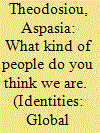

|
|
|
|
|
| Publication |
2010.
|
| Summary/Abstract |
In Parakalamos (a village in NW Greece) Gypsyness, historically constituted as a "disheveled otherness," claims a space of encounter with people and actions that are "other," but also arise from within, ossified, but also ephemeral and fleeting. By exploring the way Gypsies in Parakalamos discussed and experienced processes of identification, I shift the issue of Gypsy otherness away from the well-ordered schema of neatly divided communities usually found within Gypsy ethnography, and I am concerned with the scenography of Gypsy difference: drawing upon a more general discussion on stereotypes, identity, and difference, I explore the situatedness, instability and partial character of Gypsy performances of difference, which nonetheless cannot lie outside the topography of marginality in and through which Parakalamos Gypsies have emerged as particular historical subjects.
|
|
|
|
|
|
|
|
|
|
|
|
|
|
|
|
| 19 |
ID:
054388
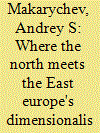

|
|
|
|
|
|
|
|